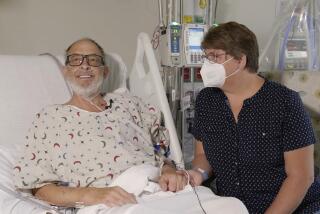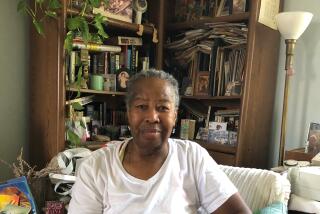Denton Cooley, Texas surgeon who performed first successful heart transplant in U.S., dies at 96
Denton Cooley, the technically brilliant and unusually dexterous Texas surgeon who performed the first successful heart transplant in the United States and the world’s first implantation of a wholly artificial heart, died Friday. He was 96.
Dubbed “Dr. Wonderful” by the media, Cooley was the leading expert on congenital heart defects in children, pioneered use of the heart-lung machine that made open-heart surgery possible, co-developed a technique for repairing torn aortic aneurysms, developed the techniques of “bloodless” heart surgery and was one of the first and most successful proponents of the coronary artery bypass graft for treating blocked blood vessels.
“What he did, more than anyone else, was make heart surgery safe,” heart surgeon Dr. O. Howard Frazier of the Texas Heart Institute in Houston told The Times in 1988.
Cooley’s team at the institute, which he founded in 1962, conducted more than 100,000 open-heart surgeries over the course of four decades, with Cooley himself performing as many as 25 per day. Throughout the 1960s and ’70s, it was the place to go for heart surgery — declining in importance only after other institutions and surgeons began to develop comparable proficiency.
“He was one of the pioneers,” said Dr. Joseph Coselli, a cardiac surgeon at Baylor College of Medicine and former president of the American Association for Thoracic Surgery. “They were doing a lot of new operations that had never been done ... and he led a team that was, from a volume standpoint, one of the largest cardiovascular programs in the world for years.”
In 1967, the International Surgical Society awarded Cooley its highest honor, citing him as “the most valuable surgeon of the heart and blood vessel anywhere in the world.”
In his autobiography, “One Life,” South African heart surgeon Dr. Christiaan Barnard wrote about observing Cooley in surgery: “It was the most beautiful surgery I had ever seen.... Every movement had a purpose and achieved its aim. Where most surgeons would take three hours, he could do the same operation in one hour. It went forward like a broad river — never obvious in haste, yet never going back.... No one in the world, I knew, could equal it.”
During a trial later in his career, Cooley was asked by a lawyer if he thought he was the greatest heart surgeon in the world. Cooley replied yes.
“Don’t you think that is being rather immodest?” the lawyer asked. “Perhaps,” he replied. “But remember, I am under oath.”
Cooley joined the Baylor University College of medicine and the affiliated Methodist Hospital in Houston in 1951, where he was united with the equally famous heart surgeon Dr. Michael DeBakey. Their commingled careers led to great triumphs and intense bitterness for both men.
While working with DeBakey, Cooley developed a new technique for repairing aortic aneurysms, bulging weak spots in the artery leading to the heart that can rupture unexpectedly, causing the patient to bleed to death.
The two also perfected a heart-lung machine — a device that would circulate and oxygenate a patient’s blood while his heart was being repaired — that DeBakey had been working on for two decades, using it successfully for the first time in 1955.
But as the pair’s rivalry got more intense, Cooley chafed under it until 1960, when he moved his practice to the nearby St. Luke’s Episcopal Hospital and Texas Children’s Hospital. A 1970 article in Life magazine quoted a colorful administrator at Houston’s Texas Medical Center as saying, “Denton just got tired of sucking hind tit.”
During the next decade, Cooley became famous for his work with congenital heart defects in children, where his surgical skill was especially important because of the small size of their hearts.
Among other things, he perfected a procedure for removing pulmonary embolisms — clots that form in the lungs — a problem that other physicians had been unable to overcome. He slit open the pulmonary artery and branches to remove clots, then squeezed the lungs flat to force out inaccessible clots.
“He was an absolutely, stunningly, exceptional clinical surgeon,” Coselli said. “In the early days of cardiovascular surgery, before we were able to protect the heart as well as we can now, accuracy was always important. But if you could have accuracy as well as speed, you were ahead of the pack — and he certainly had both.”
Cooley and his team also made great improvements in techniques for implanting artificial aortic and mitral valves to replace diseased valves. He reported in 1967 that the death rate for the procedure had declined from 70% in 1962 to about 8% five years later.
In December of that same year, Barnard reported that he had performed a heart transplant in Cape Town, South Africa. Within the next month, two American surgeons, including Dr. Norman Shumway, unsuccessfully attempted the procedure.
On May 3, 1968, Cooley transplanted a heart into Everett Thomas, 47, whose heart valves were deteriorating. The donor was a 15-year-old girl who had committed suicide. Thomas survived for 204 days and the procedure made national headlines.
During the next year, he transplanted 22 hearts, including three over a five-day period. None led to long-term survival, however, and the procedure fell into disfavor until better immunosuppressive drugs were developed.
His second transplant also sparked a legal controversy, when he used the heart from a brain-dead victim of a barroom brawl — although the term “brain dead” had not yet come into use. Two laborers involved in the fight were indicted for the death by a grand jury, but their lawyer argued that the actual moment of death came when surgeons removed the still-beating heart from the victim’s body. The charges were dismissed because of the confusion.
After a conference in Cape Town the following year to consider the ramifications of brain death, Cooley said, “I look upon the heart only as a pump, the servant of the brain. Once the brain is gone, the heart is unemployed. Then we must find it other employment.”
Cooley’s strained relationship with DeBakey came to a head on April 4, 1969, when, unable to obtain a donor heart for a transplant, he implanted an artificial heart into 47-year-old Haskell Karp. Karp survived for 65 hours with the device operating in his chest, but died of complications the day after a donor heart was finally transplanted.
DeBakey charged that Cooley and Dr. Domingo Liotta of Argentina, a former member of DeBakey’s staff, had used an artificial heart developed by DeBakey. He also accused Cooley of violating federal guidelines on human experimentation by implanting the device before its efficacy had been proved in animals.
Cooley insisted that he and Liotta had developed the device in his own lab using private funds and that the only authorization he needed to test it was the patient’s permission. He called the procedure “a desperate, rather drastic maneuver” to save a dying patient.
A special Baylor committee concluded that Cooley had violated both federal and university experimental guidelines and asked him to sign a pledge to submit any future human research plans for approval. Cooley claimed DeBakey was trying to block his research and resigned from Baylor, becoming surgeon-in-chief of the Texas Heart Institute.
Karp’s widow filed a $4.5-million lawsuit against Cooley and St. Luke’s, charging that her husband had been the subject of inappropriate human experimentation, but the suit was dismissed in 1972. The Supreme Court ultimately upheld the dismissal.
Cooley’s split with DeBakey was not healed until 2007, when DeBakey was 99 and Cooley 87.
Denton Arthur Cooley was born Aug. 22, 1920, in Houston. His grandfather was a successful real estate developer and his father was a dentist who also invested profitably in real estate — a family history that later came back to bite him.
Shy and insecure at first, he gained confidence by applying himself in school and athletics, playing tennis and basketball, especially after he grew to 6 feet, 4 inches tall. He enrolled in zoology at the University of Texas, where he starred on the varsity basketball team — becoming a lifelong fan of the team.
Graduating in 1941, he entered the Texas College of Medicine in Galveston before transferring to Johns Hopkins, where he obtained his medical degree in 1944.
He remained there for two years as an intern and resident before joining the Army, which had underwritten his education. He served as chief of surgical services at the station hospital in Linz, Austria, and was discharged in 1948 with the rank of captain.
At Hopkins, Cooley had been taken under the wing of Dr. Albert Blalock, a noted heart surgeon. In 1944, Blalock permitted him to assist in the first surgery to correct the congenital heart defect of a “blue baby,” whose malfunctioning heart prevented him from getting adequate oxygen. That experience inspired him to make heart surgery his specialty.
After completing his military service, he took another two years to complete his residency, then went to London to work with Dr. Russell Brock, who perfected techniques for operating on heart valves ravaged by disease, for a year before returning to Houston.
Cooley prospered there, both academically and financially, investing heavily in Houston’s booming, petroleum-fueled real estate market. By 1980, Forbes magazine estimated his net worth at $40 million and growing.
Financial disaster struck in 1988 when, following the collapse of the Houston real estate market, Cooley was forced to declare bankruptcy with debts of almost $100 million. At least some of the debt was accrued through risky investments with his real estate broker son-in-law Costa Kaldis.
Ironically, the bankruptcy made him even more popular with the public. “Here I was, perceived as not only a great surgeon, but also a financial genius, a huge success, an athlete, someone who does everything well,” he told The Times later that year. “Now they can bring it into clearer perspective.”
Cooley spent his limited free time with his family — who often had to rise very early in the morning or stay up late at night to see him — playing golf and playing upright bass with his all-physician band, the Heartbeats.
“He was brilliant,” Coselli said. “He had a sense of wit and humor which was legendary. He had an amazing memory. He was always very calm and the epitome of a southern gentleman. But for most of us — although he was very approachable and a very nice gentleman — we always were very aware that he was bigger than life.”
Among his many honors were the Medal of Freedom, awarded by President Ronald Reagan in 1984; the Rene Leriche Prize, the highest honor of the International Surgical Society; and the National Medal of Technology.
“We’ve lost a dear friend and transformational leader, but the world has lost a medical genius and a great humanitarian,” Dr. James T. Willerson, president of the Texas Heart Institute, said in a statement. “Dr. Cooley dedicated his life to healing hearts, and the number of lives he saved and improved over the years cannot be counted.”
Staff writer Amina Khan contributed to this article.
More to Read
Start your day right
Sign up for Essential California for the L.A. Times biggest news, features and recommendations in your inbox six days a week.
You may occasionally receive promotional content from the Los Angeles Times.






